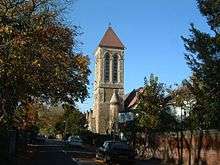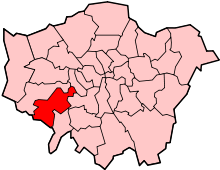East Sheen
| East Sheen | |
|---|---|
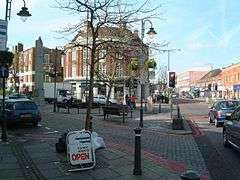 The Triangle and Upper Richmond Road | |
 East Sheen East Sheen shown within Greater London | |
| Area | 5.84 km2 (2.25 sq mi) |
| Population | 10,348 (East Sheen ward 2011)[1] |
| • Density | 1,772/km2 (4,590/sq mi) |
| OS grid reference | TQ2075 |
| London borough | |
| Ceremonial county | Greater London |
| Region | |
| Country | England |
| Sovereign state | United Kingdom |
| Post town | LONDON |
| Postcode district | SW14 |
| Dialling code | 020 |
| Police | Metropolitan |
| Fire | London |
| Ambulance | London |
| EU Parliament | London |
| UK Parliament | |
| London Assembly | |
East Sheen, also known as Sheen, is a suburb[2] of London in the London Borough of Richmond upon Thames.
Its long high street has goods stores, convenience services, offices, restaurants, cafés, pubs and suburban supermarkets and is also the economic hub for Mortlake of which East Sheen was once a manor. This commercial thoroughfare, well served by public transport, is the Upper Richmond Road West which connects Richmond to Putney. Central to this street is The Triangle, a traffic island with a war memorial and an old milestone[3] dating from 1751, marking the ten-mile distance to Cornhill in the City of London.[4]
The main railway station serving the area, Mortlake, is centred 300m north of this. Sheen has a mixture of low-rise and mid-rise buildings and it has parks and open spaces including its share of Richmond Park, accessed via Sheen Gate; Palewell Common, which has a playground, playing fields, tennis courts and a pitch and putt course; and East Sheen Common which is owned by the National Trust[3] and leads into Bog Gate, another gate of Richmond Park.
Etymology
The earliest recorded use of the name is c. 950 as Sceon and means shed or shelters. The area was designated separately from Sheen (an earlier name for Richmond) from the 13th century, as the southern manor of Mortlake.[5]
History
- Manor and hamlet status
East Sheen was a hamlet in the parish of Mortlake:
East-Sheen is a pleasant hamlet in this parish, situated on a rising ground considerably above the level of the river. It contains about ninety houses. Here are several handsome villas; the vicinity to Richmond-park, and the beauty of the surrounding country, making it a desirable situation.
Earliest references specifically to the present area of land, rather than references to parts of Mortlake, emerge in the 13th century, generally under its early name of Westhall. Originally one carucate, it was sold in 1473 by Michael Gaynsford and Margaret his wife in the right of Margaret to William Welbeck, citizen and haberdasher, of London. The Welbecks held it until selling in 1587. Later owners of what remained, the Whitfields, Juxons and Taylors were equally not titled, as with Mortlake's manorial owners, nor had an above average size or lavish manor house.[7]
- Development of the Temple Grove, Palmerston country estate
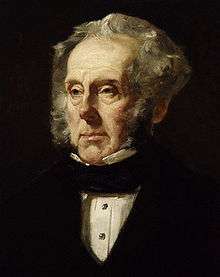
The southern estate of Temple Grove, East Sheen, first belonged to Sir Abraham Cullen, who was created a baronet in 1661. He died in 1668, and his first son Sir John in 1677. His second son Sir Rushout Cullen seems to have sold the estate shortly afterwards to Sir John Temple, attorney-general of Ireland, brother to Sir William Temple, diplomat and author, who was earlier of adjoining West Sheen, giving the home his name. It belonged to the Temples until Henry Temple, 3rd Viscount Palmerston, who later would serve as Foreign Secretary and Prime Minister, sold it soon after coming of age in 1805. It was bought by Sir Thomas Bernard, who rebuilt the Jacobean style front of the house shown in a drawing hung in the house of 1611. Sir Thomas sold it about 1811 to Rev. William Pearson who founded the Temple Grove Preparatory School for boys. The school moved in 1907 to Eastbourne and the estate was given over to house and apartment builders.[7]
East Sheen was included in the Metropolitan Police District in 1840.
Before 1900, Mortlake developed a secular vestry to help administer poor relief, maintain roads, ditches and other affairs.[8] From 1892 to 1894 Mortlake (including East Sheen) formed part of the expanded Municipal Borough of Richmond.[9] In 1894, nearby North Sheen was created as a civil parish, being split off from Mortlake and remaining in the Municipal Borough of Richmond.[10] The remainder of Mortlake (including East Sheen) was instead transferred to the Barnes Urban District,[11] which became the Municipal Borough of Barnes in 1932.
In 1965 North Sheen was incorporated into Kew[12] which, with the rest of the Municipal Borough of Richmond, joined the Municipal Borough of Twickenham and the Municipal Borough of Barnes to form the London Borough of Richmond upon Thames. In the wards of the United Kingdom, Sheen has the largest share of Richmond Park of its surrounding five wards.
Economy
East Sheen concentrates its commercial area to the main through street: its long high street has transport/furniture/hardware stores, convenience services, offices, restaurants, cafés and pubs[13] and suburban supermarkets and is also the economic hub for Mortlake of which East Sheen was once a manor. This wide-footpath street with bus lanes is the Upper Richmond Road West which connects Richmond to Putney. Central to this street is The Triangle, a tree-lined traffic island with a war memorial and an old milestone[3] at the intersection of Upper Richmond Road West with Sheen Lane. The main railway station serving the area, Mortlake, is centred 300m north of this.[14]
Churches

East Sheen lies in the ecclesiastical parish of Mortlake with East Sheen. In addition to the Parish Church of St Mary the Virgin the district has two daughter churches: Christ Church, and All Saints. Christ Church, situated near the crossroads of Christchurch Road and West Temple Sheen, was built by Arthur Blomfield on land formerly part of a farm at the entrance to Sheen Common in the 1860s. It was originally planned to be opened in April 1863; however, the tower collapsed shortly before completion and had to be rebuilt. The church was finally completed and consecrated nine months later, on 13 January 1864.[15]
All Saints was built on land bequeathed under the will of Major Shepherd-Cross, MP for Bolton who lived at nearby Palewell Lodge from 1896 until his death in 1913. The church was consecrated on All Saints' Day 1929, a year and two days after the foundation stone was laid by Elizabeth Duchess of York (later Queen Elizabeth the Queen Mother).[15]
East Sheen has three other churches: East Sheen Baptist Church, Elim Pentecostal Church and Christian City Church, which meets at Hampton Works on Sheen Lane.[16]
East Sheen has no separate Roman Catholic church; the church of St Mary Magdalen Mortlake and Our Lady Queen of Peace Church, Richmond also serve East Sheen.
Other notable features
There is a Grade II-listed air-raid shelter, dating from before the Second World War, at St Leonard's Court, a block of flats on St Leonard's Road, near Mortlake railway station.
Notable residents
Living people

- Sir Tim Berners-Lee (born 1955), computer scientist and inventor of the World Wide Web, grew up in East Sheen[17] and attended Sheen Mount Primary School.[18] A mosaic by Sue Edkins was placed at Sheen Lane Centre in June 2013 to commemorate his association with Sheen[18]
- Carol Cleveland (born 1942 East Sheen), actress and comedian, worked with Monty Python[19]
- Abigail Cruttenden (born 1968), actress[20]
- Omid Djalili (born 1965), actor and comedian[21]
- Philip Glenister ((born 1963), and Beth Goddard (born 1969), actors[22]
- Tom Hardy (born 1977), actor[23]
- Andrew Marr (born 1959), political broadcaster and Jackie Ashley (born 1954), political journalist, have lived in East Sheen[24]
- Sir Trevor McDonald (born 1939), broadcaster[25]
- Valerie Vaz (born 1954), politician and solicitor, Labour MP for Walsall South[26]
Historical figures
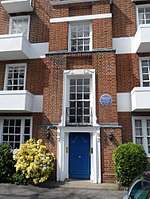
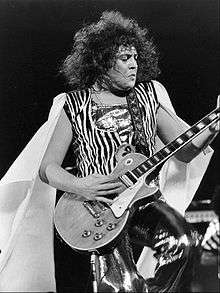
- John Partridge (astrologer) (1644–c.1714), was born at East Sheen and apprenticed to a local shoemaker. He died in Mortlake and is buried there[27]
- Robert Shirley, 1st Earl Ferrers PC (1650–1717), peer and courtier, was born in East Sheen[28]
- Sir Charles Pole, 1st Baronet (1757–1830), Admiral of the Fleet, who married Henrietta Goddard, niece of Henry Hope of Sheen House, in 1792, lived at Sheen House from 1806 onwards[27]
- Charles Grey, 2nd Earl Grey (1764–1845), British Prime Minister from 1831 to 1834, rented Sheen House from the Marquess of Ailesbury during his premiership, for use as a country house near London[29]
- Robert Stewart, 2nd Marquess of Londonderry, usually known as Lord Castlereagh (1769–1822), British Foreign Secretary, rented Temple Grove, East Sheen, from Lord Palmerston's trustees, from 1802 to 1806. His wife's mother, the Countess of Buckinghamshire, lived next door, at The Firs[27]
- Edwin Chadwick (1800–1890), social reformer, died at Park Cottage, East Sheen[30]
- Sir Henry Parker (1808–1881), Premier of New South Wales, acquired Stawell House, East Sheen, on his return to England in 1868, and his family continued there until 1935[27]
- Thomas German Reed (1817–1888), composer, musical director, actor, singer and theatrical manager, died at St. Croix, Upper East Sheen, and is buried at Old Mortlake Burial Ground.[31] With his wife Priscilla Horton (1818–95), he created the German Reed Entertainments
- The novelist Mary Anne Evans, better known as George Eliot (1819–80), took rooms at 7 Clarence Row, East Sheen (now demolished) from May to September 1855[32][33]
- Sir Arthur Blomfield (1829–99), architect, one of whose early works was Christ Church, East Sheen, designed and lived in The Cottage, now divided into two as 53 and 55 Christ Church Road[34]
- Ralph Knott (1879–1929), architect of County Hall, the former London County Council building on the South Bank, Westminster, lived and died in East Sheen[35]
- Princess Alexandra, 2nd Duchess of Fife (1891 East Sheen Lodge–1959), granddaughter of King Edward VII and great-granddaughter of Queen Victoria
- Princess Maud, Countess of Southesk (1893 East Sheen Lodge–1945), granddaughter of the British King Edward VII
- Esmond Knight (1906–1987), actor, was born in East Sheen[36]
- Desmond Hawkins (1908, East Sheen–1999), author, editor and radio personality[37]
- Frank Broadbent (1909–1983), architect, designed churches and schools for the Roman Catholic Church, lived at 71 Christchurch Road, East Sheen[38]
- Richard Dimbleby (1913–1965), radio broadcaster, was born in the borough[39] and lived in a flat at Cedar Court, East Sheen. This has been commemorated by an English Heritage blue plaque[40]
- Patricia Hornsby-Smith, Baroness Hornsby-Smith (1914–1985), Conservative Party politician, was born in East Sheen[41]
- John Chadwick FBA (1920 East Sheen–1998), linguist and classical scholar[42]
- Peter Graham Scott (1923 East Sheen–2007), film producer, director, editor and screenwriter[43]
- Don Lawrence (1928–2003), comic book artist and author, was born in East Sheen[44]
- Marc Bolan (1947–77), musician, who died at what is now the site of Bolan's Rock Shrine, a few miles from his home at 142 Upper Richmond Road West in East Sheen[45]
Education
Schools in the area include: Richmond Park Academy; Tower House Boys' Preparatory School, a small independent prep-school for boys aged 4–13; East Sheen Primary School, a state school on Upper Richmond Road West; Sheen Mount School, a state primary school on West Temple; and Thomson House School, located on Vernon Road.
Transport
The area is served by Mortlake railway station, which is 300m north of The Triangle and can be accessed from Sheen Lane. Transport for London bus routes are:
- 33
- 337 and
- 493 which serve Upper Richmond Road West.
Demography and housing
| Ward | Detached | Semi-detached | Terraced | Flats and apartments | Caravans/temporary/mobile homes/houseboats | Shared between households[1] |
|---|---|---|---|---|---|---|
| (ward) | 471 | 1,129 | 1,310 | 1,192 | 0 | 49 |
| Ward | Population | Households | % Owned outright | % Owned with a loan | hectares[1] |
|---|---|---|---|---|---|
| (ward) | 10,348 | 4,252 | 35 | 35 | 584 |
East Sheen in art
The Triangle in East Sheen is the subject of a painting, The Triangle, Sheen Lane, East Sheen, Surrey by James Isaiah Lewis (1861–1934), which is in the Richmond upon Thames Borough Art Collection and is held at Orleans House Gallery in Twickenham.[46]
See also
- Mortlake


References
- 1 2 3 Key Statistics; Quick Statistics: Population Density Office for National Statistics
- ↑ A City of Villages: Promoting a sustainable future for London's suburbs (PDF). SDS Technical Report 11. Greater London Authority. August 2002. ISBN 1 85261 393 9. Retrieved 16 January 2014.
- 1 2 3 "Barnes, Mortlake and Sheen". Visit Richmond. London Borough of Richmond upon Thames. Retrieved 4 January 2014.
- ↑ "East Sheen Milestone". Milestones. Waymarking.com. 20 February 2008. Retrieved 4 January 2014.
- ↑ Anthony David Mills (2001). Oxford Dictionary of London Place Names. Oxford University Press. ISBN 0-19-280106-6.
- ↑ Daniel Lysons (1792). "Mortlake". The Environs of London: volume 1: County of Surrey. Institute of Historical Research. Retrieved 6 September 2016.
- 1 2 H E Malden, ed. (1912). "Parishes: Mortlake". A History of the County of Surrey: Volume 4. Institute of Historical Research. pp. 69–74. Retrieved 6 September 2016.
- ↑ IGEW John Marius Wilson: Imperial Gazetteer of England and Wales (1870–72)
- ↑ Vision of Britain – Mortlake parish Archived 30 September 2007 at the Wayback Machine. (historic map Archived 30 September 2007 at the Wayback Machine.)
- ↑ Vision of Britain – North Sheen parish Archived 1 October 2007 at the Wayback Machine. (historic map Archived 1 October 2007 at the Wayback Machine.)
- ↑ Vision of Britain – Barnes UD/MB Archived 30 September 2007 at the Wayback Machine. (historic map Archived 30 September 2007 at the Wayback Machine.)
- ↑ David Blomfield (1994). Kew Past. Phillimore & Co. Ltd. p. 131. ISBN 0-85033-923-5.
- ↑ "Restaurants in Mortlake / East Sheen". Square Meal. Retrieved 6 September 2016.
- ↑ Grid square map Ordnance Survey website
- 1 2 Halfpenny Green – Postcards from Barnes and Mortlake. Picton. pp. 40–41. ISBN 0-948251-78-6.
- ↑ "Christian City Church". Find a Church. UK Church Directory Limited. Retrieved 15 March 2015.
- ↑ Daniel S. Morrow (23 April 2001). "Tim Berners-Lee Oral History" (PDF). ComputerWorld Honors Program International Archives. Retrieved 9 October 2012.
- 1 2 Gabriela Kerezova (27 June 2013). "Worldwide Web founder honoured at Sheen Lane Centre". Richmond and Twickenham Times. Retrieved 4 July 2013.
- ↑ IMDb Database retrieved 19 January 2018
- ↑ "Conflict of the heart". Richmond and Twickenham Times. 31 May 2013. p. 35.
- ↑ "Comedian Omid Djalili who starred in Gladiator gets let off driving ban after employing Mr Loophole lawyer". Daily Mail. London. 14 June 2013. Retrieved 7 July 2013.
- ↑ Daphne Lockyer (3 June 2001). "Interview: Beth Goddard – The woman who went wife-swapping with Robson Green; But sadly for Beth Goddard it was only for a new TV drama, she tells Daphne Lockyer". The Free Library. Retrieved 10 October 2012.
- ↑ Colin Daniels (12 May 2013). "Tom Hardy 'buys £2m London home'". Digital Spy. Retrieved 3 February 2018.
- ↑ Elizabeth Grice (12 May 2007). "The view from Marr". The Daily Telegraph. London. Retrieved 28 December 2013.
- ↑ Christine Fleming (14 May 2010). "Broadcaster Sir Trevor McDonald's wife called police after seeing a teenager acting suspiciously near her East Sheen home". Richmond and Twickenham Times. Retrieved 12 April 2013.
- ↑ Record in Parliament at TheyWorkForYou, Valerie Vaz, Shadow Leader of the House of Commons retrieved 19 January 2018
- 1 2 3 4 "People of Mortlake, Barnes and East Sheen: M – S" (PDF). Barnes and Mortlake History Society. Retrieved 13 October 2012.
- ↑ "Sir Robert Shirley, 1st Earl Ferrers". Twickenham Museum. Retrieved 3 February 2018.
- ↑ "People of Mortlake, Barnes and East Sheen: E – G" (PDF). Barnes and Mortlake History Society. Retrieved 13 October 2012.
- ↑ Marjie Bloy (14 October 2002). "Edwin Chadwick (1800–1890)". The Victorian Web. Retrieved 26 September 2012.
- ↑ Jane W Stedman "Reed, (Thomas) German (1817–1888)", Oxford Dictionary of National Biography, Oxford University Press, 2004; online edition, January 2008, accessed 1 February 2013 (subscription or UK public library membership required)
- ↑ "George Eliot (Mary Anne Evans: 1819–1880)". Local History Notes. London Borough of Richmond upon Thames. Archived from the original on 1 December 2012. Retrieved 9 October 2012.
- ↑ K A L Parker (1987). "George Eliot and Richmond 1855–1859". Richmond History, journal of the Richmond Local History Society (42–51). ISSN 0263-0958.
- ↑ "Local architects" (PDF). People of Mortlake, Barnes and East Sheen. Barnes and Mortlake History Society. Retrieved 4 January 2014.
- ↑ "People of Mortlake, Barnes and East Sheen: H-L" (PDF). Barnes and Mortlake History Society. Retrieved 16 May 2014.
- ↑ IMDb Database retrieved 19 January 2018
- ↑ Leonard Miall (7 May 1999). "Obituary, Desmond Hawkins". The Independent. Retrieved 19 January 2018.
- ↑ Dictionary of Scottish Architects, Francis George Broadbent retrieved 19 January 2018
- ↑ Nick Barratt (3 February 2007). "Family detective". The Telegraph. London. Retrieved 11 October 2012.
- ↑ "English Heritage blue plaque for Richard Dimbleby". English Heritage. 25 January 2013. Retrieved 2 September 2016.
- ↑ "Index entry". FreeBMD. ONS. Retrieved 7 June 2011.
- ↑ "John Chadwick" (PDF). British Academy. Retrieved 3 February 2018.
- ↑ IMDb Database retrieved 19 January 2018
- ↑ Don Lawrence at Lambiek's Comiclopedia retrieved 19 January 2018
- ↑ "East Sheen". Hidden London. Retrieved 31 October 2012.
- ↑ "The Triangle, Sheen Lane, East Sheen, Surrey". Art UK. Retrieved 3 February 2018.
External links
- East Sheen Village
- Barnes and Mortlake History Society (which also covers East Sheen)
